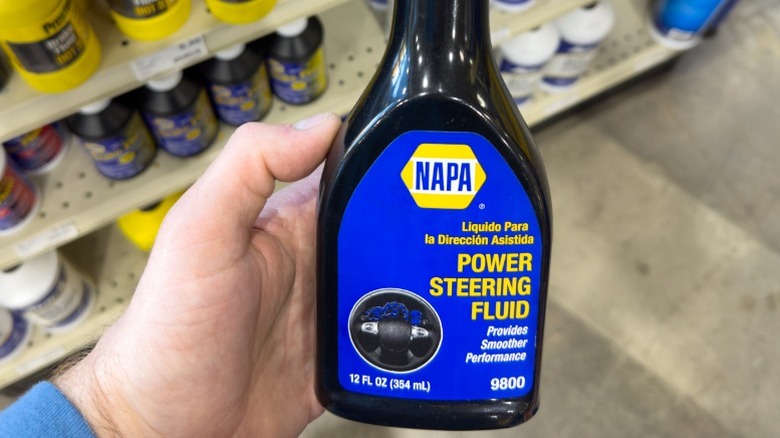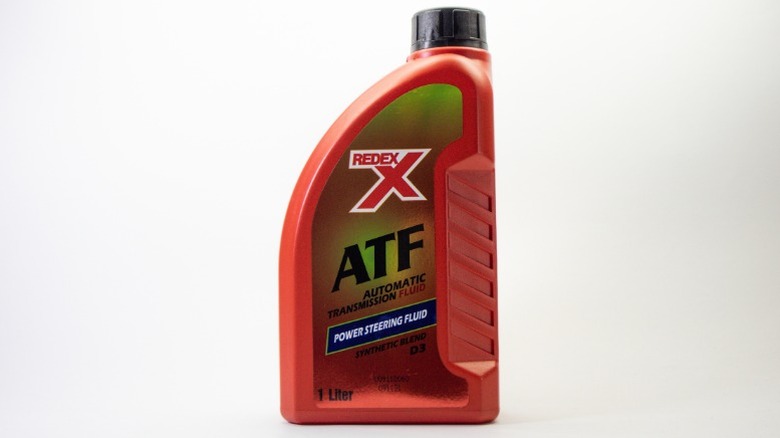Transmission Vs. Power Steering Fluid: What's The Difference Between Them?
Modern vehicles rely on a host of fluids to send us down the road. Some, like engine oil and coolant, are well-known, while others, like differential fluid, are less-familiar to average motorists. Regardless of whether you're an automotive fluid expert or novice, if you own and drive a car, you need to maintain these fluids regularly. If you visit a professional shop for maintenance jobs, you don't have to worry about understanding the difference between them and how to service them.
However, if you're into DIY car jobs, it's important to recognize each of the fluids your vehicle uses, not only for performing maintenance tasks, but also for recognizing and identifying leaks. It's usually pretty easy to tell the difference between standard liquids like engine oil and coolant or gasoline and brake fluid, thanks to characteristic smells, consistencies, and colors. However, for things like transmission fluid and power steering fluid, which are often both red with similar odors, understanding the differences can be tricky.
Depending on your car's age and the type of gearbox it has, there may be many differences between the fluids used in its transmission and power steering system. Manual transmission fluid is generally a brownish, amber color, while automatic transmission fluid (ATF) is usually red. Power steering fluid is also usually red. However, there are often chemical differences between these liquids, like the addition of detergents and other additives to reduce friction in transmissions. If you're interested in a deeper dive into the differences between these fluids, as well as an explanation of whether they can ever be used interchangeably, stick around. As a lifelong car nerd and former professional mechanic, I'll break it all down for you.
What is transmission fluid?
Transmission fluid, as the name implies, is designed to help your car's gearbox work smoothly and properly. Most automotive transmissions — whether they're manual or automatic — rely on various internal gears to function. Transmission fluid performs a few key functions to help those gears move smoothly so you can accelerate and decelerate at different speeds. One of the primary functions of transmission fluid is to provide lubrication to the internal gears and other moving parts.
Like engines, transmissions require lubrication to facilitate smooth movement, reduce friction, and prevent the buildup of excess heat. However, transmission fluid also operates as a hydraulic fluid to do things like actuate clutch plates and engage the torque converter, enabling you to shift gears and allowing engine power to travel through the transmission. The fluid generally contains additives like detergents and anti-wear or anti-friction compounds to help prevent wear and damage to sensitive gears and other parts.
There are a few different types of transmission fluid. Manual transmission fluid is used in older vehicles with standard transmissions. It's generally more viscous or thicker than ATF and can be amber or a clear gold color. ATF or automatic transmission fluid is what you'll find in most contemporary vehicles, even in some with manual transmissions. ATF is usually bright red when fresh and clean. Continuously variable transmission (CVT) fluid is used in vehicles with continuously variable transmissions. These types of gearboxes rely on belts and pulleys instead of gears to provide infinite gear speeds, as opposed to traditional transmissions which have a set number of gears. These transmissions require a special type of fluid with additional anti-friction components to help prevent damage to the belts and slipping.
What is power steering fluid?
Like transmission fluid, power steering fluid performs a few key functions, including providing lubrication and hydraulic pressure to the power steering system. However, before we dive deeper into the chemical composition of power steering fluid, it may be helpful to explain how the system works.
Modern automotive power steering systems generally fall into one of two broad categories: electric or hydraulic. While electric systems are becoming more prevalent, hydraulic systems are still incredibly common. These devices rely on hydraulic pressure to help us turn the steering wheel. There are various types of power steering systems, but one of the most common is rack and pinion steering. In cars with hydraulic versions of this system, a power steering pump pressurizes the hydraulic fluid and sends it to the rack and pinion steering gear. That hydraulic pressure helps actuate the gear from one side to the other, allowing you to turn the steering wheel with substantially less force.
The power steering fluid is an integral part of this system. It provides the hydraulic pressure necessary to help us turn our steering wheels. However, it also provides lubrication to the steering gear to prevent friction, mechanical damage, and the development of excess heat. Different automakers use different types of power steering fluid with various viscosities and additives. In comparison to transmission fluid, power steering fluid is often able to withstand higher temperatures, but it may contain fewer anti-friction components and detergents. Power steering fluid is usually bright red when fresh and new, but it can become very dark if you don't maintain it properly or if you need to service the power steering system.
Are power steering fluid and transmission fluid ever interchangeable?
If you've ever heard someone say that power steering fluid and transmission fluid are the same, don't worry — the statement can be true or false, depending on the type of vehicle. That's because, as mentioned, different automakers use different types of power steering fluid in the cars they build. For many modern vehicles, power steering fluid comes in the form of ATF or automatic transmission fluid, which is why many people think that all power steering fluid and transmission fluid are the same. However, ATF is not the only type of fluid used in hydraulic power steering systems. Other automotive manufacturers use things like synthetic power steering fluid, which, unlike other forms, does not have an oil base and is created in a lab, while other vehicles use various forms of universal or mineral-based oils.
All of that said, just because there are various different types of transmission fluid, and just because many vehicles use ATF for both the transmission and power steering systems, does not mean that all of these fluids are interchangeable. It's vital that you follow the manufacturer's instructions when servicing these systems. If you visit a pro, they should use the correct fluid types when performing things like flushes. However, if you plan to DIY your auto maintenance, you'll need to check your vehicle owner's manual to be sure you use the proper fluids.
How to tell the difference between transmission and power steering fluid
Generally, you shouldn't have to identify transmission fluid or power steering fluid by sight alone. If you're into DIY automotive maintenance tasks, you should follow your owner's manual, as mentioned, or purchase a vehicle-specific repair guide to walk you through various car jobs. That means that you should be purchasing your fluids based on expert guidance and the manufacturer's recommendations. Then, if your vehicle uses different fluids for the transmission and power steering systems, all you have to do is ensure that you pour the fluids into the correct part of the car.
However, if you end up with a red fluid leak, you may have trouble determining whether it's coming from the transmission or power steering system. In this case, there are some things you should do to help narrow down the source of your problem. The best way to identify the fluid is to pinpoint the leak's origin. A great way to do this is to first wash the vehicle thoroughly, including cleaning the engine bay and undercarriage. Then, use a flashlight to look for any leaking fluid. Examine the power steering system, including everything from the pump to the fluid lines and the steering gear, as well as the transmission.
A transmission fluid leak is likely to leave puddles of fluid more toward the middle of your vehicle, while a power steering fluid leak may leave puddles under the engine bay. Besides identifying the source of the leak, you should also pay attention to any other signs of trouble. Things like difficult shifting gears or grinding and clunking sounds may indicate transmission problems, while a squealing sound when you turn the wheel or a stiff steering wheel can indicate issues with the power steering system.




